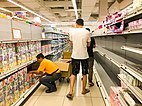
Back جائحة فيروس كورونا في سنغافورة Arabic پەتای جیھانیی کۆڤید-١٩ لە سینگاپوور CKB COVID-19-Pandemie in Singapur German Pandemia de COVID-19 en Singapur Spanish دنیاگیری کووید-۱۹ در سنگاپور Persian Pandémie de Covid-19 à Singapour French מגפת הקורונה בסינגפור HE Pandemi Covid-19 di Singapura ID Pandemia di COVID-19 a Singapore Italian Pageblug Covid-19 ing Singapura JV
| COVID-19 pandemic in Singapore | |
|---|---|
(clockwise from top left)
| |
| Disease | COVID-19 |
| Virus strain | SARS-CoV-2 |
| Location | Singapore |
| First reported | Wuhan, Hubei, China |
| Index case | Sentosa, Southern Islands |
| Arrival date | 23 January 2020 (3 years, 2 weeks and 6 days) |
| Confirmed cases | 3,006,155[1] |
| Recovered | 2,516,440 (updated 23 July 2023) [2] |
Deaths | 2,024[1] |
| Fatality rate | 0.07% |
| Vaccinations | |
| Government website | |
| www | |
The COVID-19 pandemic in Singapore was a part of the worldwide pandemic of coronavirus disease 2019 (COVID-19) caused by severe acute respiratory syndrome coronavirus 2 (SARS-CoV-2). The first case in Singapore was confirmed on 23 January 2020. Early cases were primarily imported until local transmission began to develop in February and March. In late March and April, COVID-19 clusters were detected at multiple migrant worker dormitories, which soon contributed to an overwhelming proportion of new cases in the country.
To stem the tide of infections, strict circuit breaker lockdown measures were implemented from 7 April to 1 June 2020, after which restrictions have been gradually lifted as conditions permitted.[4] A mass vaccination campaign was launched, and has been successful in achieving a very high vaccination rate, with more than 96% of the eligible populace having completed their vaccination regimen as of June 2022.[5][6] Various measures have been taken to mass test the population for the virus and isolate infected people. Contact tracing measures SafeEntry and TraceTogether were implemented to identify and quarantine close contacts of positive cases.
The last record of COVID-19 cases was on 4 June 2023, which was at 2,481,404 confirmed cases, 2,456,295 recoveries and 1,727 deaths,[7] with a case fatality rate of 0.08%, one of the lowest in the world.[8] It introduced what was considered one of the world's largest and best-organised epidemic control programmes.[9][10]
- ^ a b Mathieu, Edouard; Ritchie, Hannah; Rodés-Guirao, Lucas; Appel, Cameron; Giattino, Charlie; Hasell, Joe; Macdonald, Bobbie; Dattani, Saloni; Beltekian, Diana; Ortiz-Ospina, Esteban; Roser, Max (2020–2024). "Coronavirus Pandemic (COVID-19)". Our World in Data. Retrieved 21 January 2025.
- ^ "COVID - Coronavirus Statistics - Worldometer".
- ^ a b "Vaccination Statistics". Ministry of Health. Archived from the original on 23 November 2022. Retrieved 23 November 2022.
- ^ Cite error: The named reference
endingcircuitbreakerwas invoked but never defined (see the help page). - ^ Cite error: The named reference
dw-vaxwas invoked but never defined (see the help page). - ^ "COVID-19 Vaccination". www.moh.gov.sg. Retrieved 23 June 2022.
- ^ Hannah Ritchie; Edouard Mathieu; Lucas Rodés-Guirao; Cameron Appel; Charlie Giattino; Esteban Ortiz-Ospina; Joe Hasell; Bobbie MacDonald; Diana Beltekian; Saloni Dattani; Max Roser (2020–2021). "Coronavirus Cases (COVID-19)". Our World in Data. Retrieved 9 October 2021.
- ^ "COVID-19 Mortality Analyses". Johns Hopkins University of Medicine.
- ^ Barron, Laignee (13 March 2020). "What We Can Learn From Singapore, Taiwan and Hong Kong About Handling Coronavirus". Time. Archived from the original on 24 March 2020. Retrieved 24 March 2020.
- ^ Geddie, John; Aravindan, Aradhana (17 September 2020). "Why is Singapore's COVID-19 death rate the world's lowest". Reuters. Archived from the original on 3 October 2020. Retrieved 17 September 2020.



